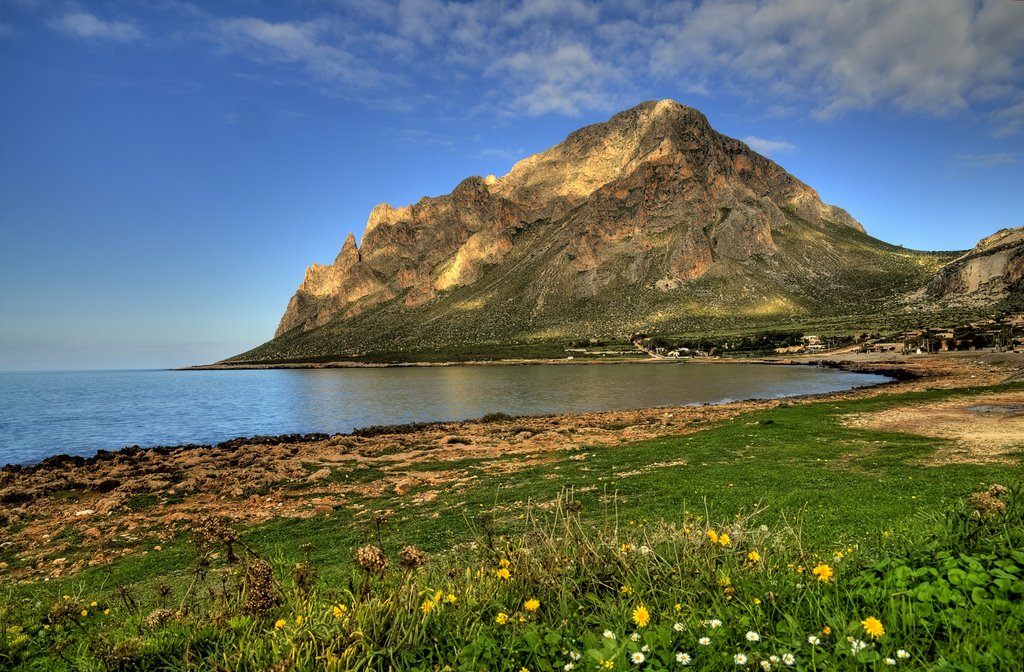Mount Cofano Nature Reserve
Mount Cofano Nature Reserve – Custonaci
Mount Cofano (659 meters high) is situated between the Gulf of Bonagia and Gulf of Cofano.
Mount Cofano Oriented Nature Reserve belong to the territory of Custonaci and covers an area of 537 hectares. It is a very important area from the naturalist, speleological, historical, popular points of view and for the landscape.
The rich Mediterranean vegetation interrupts the harsh and savage look of the dolomitic massif while on the sides there are some caves inhabited since the Paleolithic period where today take place the wonderful Living Crib of Custonaci.
Downhill the sighting towers recall when the costs had to be defended from pirates attacks and the ruins of an ancient tonnara testify the importance that tuna fishing had both there and throughout the surrounding territory.
The landscape is spectacular. From the top of the Mount the sea seems more blue in contrast with the green of the Gulf shores.
The Caves – There are many caves interesting from the geological and paleontological point of view on the sides of Mount Cofano where a lot of fossils, tools and graffitos attesting the human presence from the Upper Palaeolithic period were founded. The most famous cave is the Grotta di Scurati, near the omonymous village, where each year at Christmas the Living Crib takes place.
Itineraries
– A relaxing path along the coast follows the perimeter of the promontory. It takes two hours to be fully done but you can choose not to complete it.
– An internal path reaches the top of the Mount. From there you can admire a wonderful view of the gulf. The slope requires agility and wellness because of the passages between the rocks. It can take up to three hours depending on the starting point. It is advisable not to choose this trail in the hottest hours of the day.
FLORA & FAUNA
Flora – Thanks to its rich vegetation (325 plant species of which 19 are endemic) the promontory is a biotype very interesting from the naturalist and environmental point of view. The landscape is characterized by meadows of Disa, one of the more representative herbaceous of the Mediterranean area, and by the Fan palm, another species typical of these areas.
You may also find the Lentisk with a rich irregular frond, the Terebinth, a resinous small shrub, the Heater, the Ilex that can reach 20 meters in height and the Cork-tree with an oval and rich frond. These species belonged to the preexistent maquis.
The Erica sicula, a very rare woody-branch bush with pink flowers, the Helichrysum rupestre var. cophanense, the Phagnalon metlesicsii, a small perennial plant with white flowers, the rare Hieracium cophanense, an endemic species living in the calcareous rocks north exposed of the Mount Passo del Lupo (Zingaro) and of the Mount Cofano, the Cavolo of Trapani, an endemic perennial plant that can be found only there and in the Egadi islands, and the Silverbush are endemic species of the area.
Along the coast you can find the Limonium bocconei, the Crithmum maritimum, the Astericus maritimus, the Lotus cytisoides, the Silene sedoides, the Ferula and the Yellow hornpoppy with large yellow flowers.
Fauna – Birds… – The birdlife is rich and varied. More than 50 species nest on the mount. There are also very rare species such as a pair of Bonelli’s Eagles, an endangered species of lonely birds of prey, and the Woodchat Shrike that can be recognized by the red stripe on its head.
In the rocky walls of the Mount you can see the Peregrine Falcon, known for its speed when it dives on the prey, the Raven with very large wings, the Herring-gull, the Blue Rock Thrush, a lot of Swifts, the Cormorant and the Rock Partridge, a rare species that thanks to this nature reserve can continue surviving.
The nocturnal birds of prey are widespread. The Owlet and the Horned Owl nest especially among the arboreal vegetation while the Barn Owl and the Tawny Owl prefer the hollows of the rock walls. It is important to stress the adaptation to the area of the Tawny Owl who utilized the natural cavities instead of looking for forests to which it is used to.
The bird-watching can truly surprise you because there are a lot of migratory species that in spring and at the beginning of autumn rest in the reserve and in the sea in front of it. You can see for example the Kingfisher and the Stilt-bird. There are a lot of birds of prey as a consequence of the abundance of invertebrates, insects, but especially reptiles and small mammals that they can prey on.
…and other animals – The Porcupine is the most common mammal of the reserve while the Etruscan shrew, the smallest mammal in Europe, and the Sicilian shrew, an endemic species of the Sicilian-Maltese insular complex, are the most common among insectivores. Among the amphibians it is important to emphasize the presence of Discoglossus, an endangered species endemic to Sicily.

